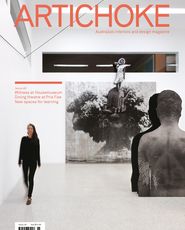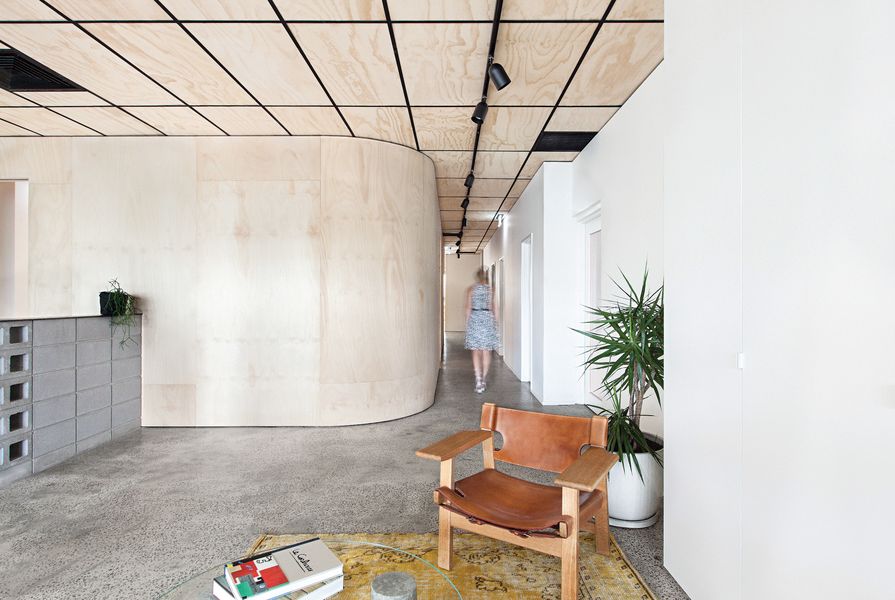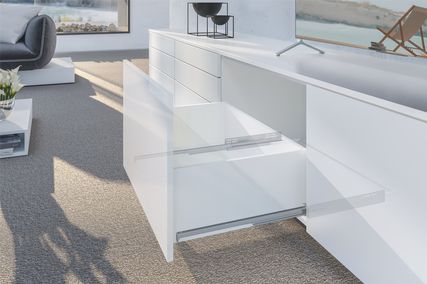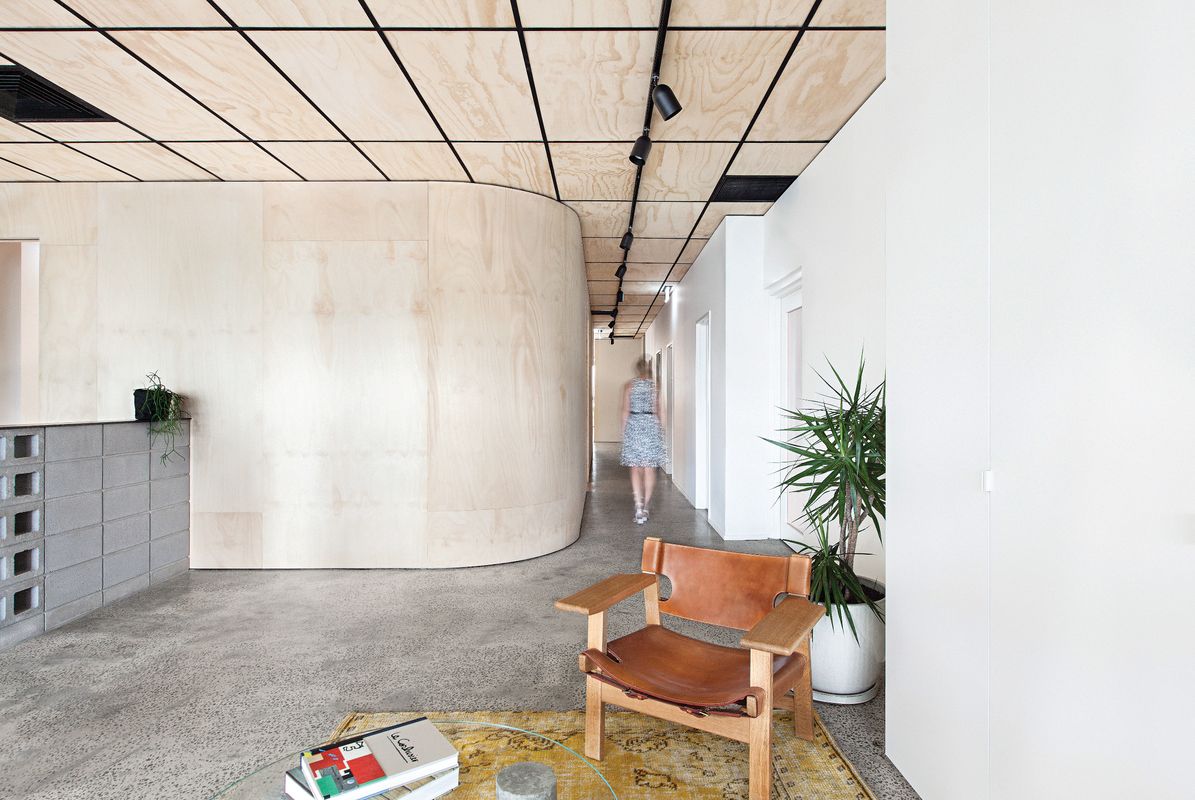Clare Cousins Architects’ folio of work is diverse, but it is the studio’s extensive residential work that has allowed it to master a certain attention to detail. This attention to detail has been carried through to the refurbishment and fitout of the Blackwood Street Bunker, the firm’s new shared studio premises in North Melbourne. “The Bunker,” as it has been dubbed, is an exercise in tailoring the design of a workspace to house two organizations, and acknowledging their specific work cultures in the creation of an aesthetically consistent and harmonious whole.
The offices are housed in a building that only an architect could love, and one that was so well disguised that perhaps only an architect could have seen its potential. A somewhat tentative love poem to concrete brutalism, the building was coated in a bilious custard-coloured render and had an internal rabbit warren of medical suites subsisting off the nearby Royal Melbourne Hospital. The building could have easily fallen victim to the wrecking ball, especially given its outsized neighbours and the redevelopment potential of the site. However, this was not to be and the building was saved and given a new purpose.
Now home to the architects, who share it with a construction company (on the same level) and a graphic design studio (on the lower level), the building has been stripped of its render. This revealed a rather lovely raw concrete along with traces of painted signage across the facade. The architecture firm’s half of the upper floor is on the northern side, and one approaches the studio via an echoing concrete stairwell, the walls of which are painted in a rich mid-blue. This bare-bones approach to the materiality of the building is just a taste of things to come.
The offices are housed in a concrete brutalist building that “only an architect could love.”
Image: Lisbeth Grossman
Entering the studio through a glazed door, the visitor is presented with a vista characterized by a clean and direct approach to materials. Plywood dominates (a material explored in other projects by Clare Cousins Architects), and both walls and joinery are finished in this material. The designer’s impact on the shell of the building has been minimal and strategic, involving the removal of a section of internal wall that previously divided the floor into two disconnected tenancies. This was accompanied by the installation of a north-facing glazed wall that spills light into the construction company’s half of the floor.
A generous, tiled kitchen with an enormous dining table and an oh-so-necessary espresso machine forms the linchpin between the architecture firm and the construction company. The kitchen, which is easily accessible from both tenancies, provides an informal gathering space and encourages interaction between all employees. The benefits to both businesses of this social cross-pollination are intangible, but important nonetheless.
The two distinct office spaces radiate out the central kitchen and the design of each workplace is uniquely tailored to its tenant’s particular work culture. On the one hand, the architecture studio is a single, open-plan space, just big enough for the team of eight professionals to operate in close, but not cramped, proximity. Surrounded by half-height joinery units that contain the space, this one creative sandpit is where all the magic happens. An adjacent open-plan meeting room is available for group discussions, and a second closed meeting room affords privacy for different kinds of exchange. This is a classic studio, designed to reflect the management style of the one-director practice: open, flat-structured, and all-in-together.
The architecture studio is a space just the right size for the team of eight who work together closely.
Image: Lisbeth Grosmann
On the other hand, the design of the construction company’s office reflects the very different, and more layered, structure of that business. Open-plan work areas sit alongside the directors’ individual glazed offices, and the office for the finance and estimating team is given a different, more contained character somewhere between open- and closed-plan. A discrete meeting room attached to the finance area is available for internal administrative meetings, while the front-of-house and reception area are each given a distinctive flavour. While construction companies often use their offices to showcase their ability to deliver polished and “slick” design with expensive finishes and fine detail, in this case a refreshingly direct and almost industrial materiality is on display. In addition to the extensive use of plywood and glazed partitions, concrete blocks have been used to create a screen around a meeting table, a feature that resonates well with the base building.
Despite the very different cultures that each of the fitouts support, both offices are filled with light and are airy and clean-cut in their presentation. This forms a distinct contrast to the heavy weight of the host building as seen from the street, and the contrast between expectation and reality is invigorating.
Next year marks the tenth year of operation for Clare Cousins Architects and it is fitting that this compact studio of eight practitioners will enter its second decade of practice in a bespoke setting. This confident interior is well crafted, carefully considered and further evidence of a practice that has much to offer but nothing to prove.
Products and materials
- Walls and ceilings
- Hoop pine ply walls, joinery and ceiling tiles. New concrete blockwork, unfinished. Existing concrete blockwork, painted.
- Windows
- Powdercoated aluminium windows.
- Doors
- Custom-made steel-framed doors to offices and meeting rooms.
- Flooring
- Existing concrete slab, polished.
- Lighting
- Comet spotlight and Beama Surface Eye Baby downlight, both from Masson for Light.
- Furniture
- Vintage Børge Mogensen Spanish Chair. Van sofa from Jardan. A-joint trestle tables (with marble tabletops) by Henry Wilson. Bronte tables from Eco Outdoor. Custom-made glass coffee table with cast concrete legs. Custom-made hoop pine joinery.
- Kitchen
- Ceramic wall tiles from Classic Ceramics. Stainless steel countertops. Solid maple table top on concrete pipe legs.
- Bathroom
- Astra Walker tapware from Mary Noall. Ceramic wall tiles from Classic Ceramics.
- Heating/cooling
- External vertical sunscreen blinds. Extensive cross-ventilation from recently installed operable doors and windows.
- Roofing
- Existing roofing with new insulation.
- External elements
- New timber decking.
- Other
- Dion Horstmans sculpture in boardroom. Rug from Loom Rugs. Custom-made hoop pine joinery.
Credits
- Project
- Blackwood Street Bunker
- Design practice
- Clare Cousins Architects
Melbourne, Vic, Australia
- Project Team
- Clare Cousins, Dita Beluli, Jacky Chan, Oliver Duff, Jessie Fowler, Catherine Parkinson, Felicity Wabitsch, Tara Ward
- Consultants
-
Builder
Maben Group
Landscaping Eckersley Garden Architecture
Render removal Don Giampa
- Site Details
-
Location
Melbourne,
Vic,
Australia
Site type Urban
- Project Details
-
Status
Built
Completion date 2013
Design, documentation 4 months
Construction 6 months
Category Interiors
Type Workplace
Source

Project
Published online: 1 Dec 2014
Words:
Marcus Baumgart
Images:
Lisbeth Grosmann,
Lisbeth Grossman
Issue
Artichoke, September 2014

























